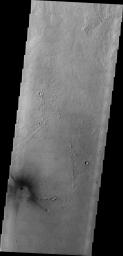
|
Big Blast
- Click the image above for a larger view
- Full-Res JPEG (1331 x 2769) (541.0 kB)
- Full-Res TIFF (1331 x 2769) (3.7 MB)
Caption:

Context image for PIA10856
Big Blast
East of Jovis Tholus and in the midst of the Tharsis Volcanic field this dark, rayed spot is seen. Most likely this mark represents the shock wave of an incoming meteoroid that burned up before impact. The shock wave blasted the fine material away, leaving the darker basaltic surface exposed.
Image information: VIS instrument. Latitude 17.3°N, Longitude 246.5°E. 18 meter/pixel resolution.
Note: this THEMIS visual image has not been radiometrically nor geometrically calibrated for this preliminary release. An empirical correction has been performed to remove instrumental effects. A linear shift has been applied in the cross-track and down-track direction to approximate spacecraft and planetary motion. Fully calibrated and geometrically projected images will be released through the Planetary Data System in accordance with Project policies at a later time.
Background Info:
Please see the THEMIS Data Citation Note for details on crediting THEMIS images.
NASA's Jet Propulsion Laboratory manages the 2001 Mars Odyssey mission for NASA's Office of Space Science, Washington, D.C. The Thermal Emission Imaging System (THEMIS) was developed by Arizona State University, Tempe, in collaboration with Raytheon Santa Barbara Remote Sensing. The THEMIS investigation is led by Dr. Philip Christensen at Arizona State University. Lockheed Martin Astronautics, Denver, is the prime contractor for the Odyssey project, and developed and built the orbiter. Mission operations are conducted jointly from Lockheed Martin and from JPL, a division of the California Institute of Technology in Pasadena.
Cataloging Keywords:
| Name | Value | Additional Values |
|---|---|---|
| Target | Mars | |
| System | ||
| Target Type | Planet | |
| Mission | 2001 Mars Odyssey | |
| Instrument Host | Mars Odyssey | |
| Host Type | Orbiter | |
| Instrument | Thermal Emission Imaging System (THEMIS) | |
| Detector | ||
| Extra Keywords | Grayscale, Impact, Thermal, Volcano | |
| Acquisition Date | ||
| Release Date | 2008-08-13 | |
| Date in Caption | ||
| Image Credit | NASA/JPL/ASU | |
| Source | photojournal.jpl.nasa.gov/catalog/PIA10856 | |
| Identifier | PIA10856 | |
